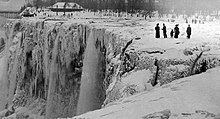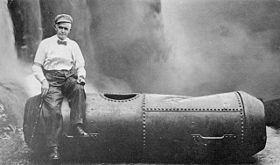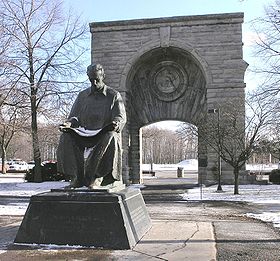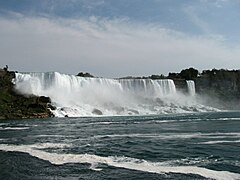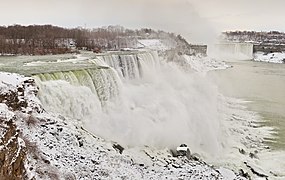Niagara Falls
The Niagara Falls (Niagara Falls in English, Chutes du Niagara in French) are a set of waterfalls located on the Niagara River, in the northeastern part of North America, between Canada and the United States. Located at about 236 meters above sea level, its drop is approximately 51 meters.
They comprise three waterfalls: the “Canadian Falls” (Ontario), the “American Falls” (New York) and the smaller “Bridal Veil Falls”. Although they do not have a great height, they are very wide and are the most voluminous in North America, since all the water of the Great Lakes passes through them. Between the Canadian and American falls is the Isla de la Cabra, Goat Island.
Since they were discovered by European settlers they have become very popular, not only for their beauty but also for being a source of energy and a challenging environmental conservation project. They are a place of tourism shared by the cities of Niagara Falls (New York) and Niagara Falls (Ontario).
The name "Niagara" comes from an Iroquois word meaning "water thunder." The original inhabitants of the region were the Ongiara, an Iroquois tribe called the neutrals by the French conquerors, who found in them help as mediators of disputes with other tribes.
Niagara Falls' historical roots lie in the ice age that ended about 10,000 years ago. Both the North American Great Lakes region and the Niagara River are effects of this continental glaciation. It was a huge glacier that advanced over the eastern part of Canada like a big bulldozer grinding rocks and soil, removing them and deepening some river channels until they became lakes.
Historical setting
There is controversy over who was the first European to give a written description of the cataracts. The area was visited by Samuel de Champlain in 1604. Members of his group informed him of the existence of spectacular cataracts, which were mentioned in his travel diary, but never seen by him. Some claim that the naturalist Pehr Kalm made the first description of the cataracts during an expedition to the area at the beginning of the centuryXVIII. However, most historians agree that Father Louis Hennepin observed them and described them much earlier, in 1677, after travelling to the area with the explorer René Robert Cavelier of La Salle. Hennepin was also the first to describe the San Antonio Falls in Minnesota. During the centuryXIX tourism popularized them and was the most industrialized area in the middle of the century. The demand to observe them made a pedestrian bridge built in 1848 and then the Charles Ellet Niagara suspension bridge. This was replaced by the suspension bridge of the Niagara Falls of John Augustus Roebling in 1855. In 1886 Leffert Buck replaced the bridge of Roebling, built in wood and stone, by one where steel predominates, which still today carries a railing line on the falls. The first steel bridge near the falls was completed in 1897, now known as Whirlpool Rapids Bridge. It has passage for vehicles, trains and pedestrians between Canada and the United States just below the falls. In 1941 the third step was completed with the Rainbow Bridge, which allows the transit of vehicles and pedestrians. |
Especially after World War I, tourism boomed as automobiles made getting to the falls much easier. The history of Niagara Falls in the 20th century is largely one of efforts to harness the energy of the falls to produce hydropower and control the sprawl on both the American and Canadian sides, which threaten the natural beauty of the place. In the early 1980s, the US Army Corps of Engineers filled in more land and built diversion dams and retaining walls to keep water out of Terrapin Point. In all, 400 feet (120 m) of Horseshoe Falls were removed, including 100 feet (30 m) on the Canadian side. According to author Ginger Strand, Horseshoe Falls is currently entirely in Canada. Other sources say that "most" of the Horseshoe Falls is located in Canada.
Impact on industry and commerce
The falls were early recognized as a potential source of energy. The first known effort to harness it was in 1759, when Daniel Joncairs built a small canal over the falls to provide power for his sawmill. Augustus and Peter Porter purchased this area and all of the North American Falls in 1805 from the New York government and lengthened the canal to provide water power for their flour mill and tannery. In 1853, the Niagara Falls Hydraulic Power and Mining Company was contracted to build canals that would be used to generate electricity. In 1881, under the command of Jacob Schoellkopf, they were able to produce enough direct current to illuminate the falls and the nearby towns.
When Nikola Tesla, who later had a monument built at the falls, discovered alternating current, the transfer of electricity over distances became possible. In 1893, the "Niagara Falls Power Company" hired George Westinghouse to design a system capable of generating alternating current. In 1896, with funding from J.P. Morgan, John Jacob Astor IV, and Vanderbilt, gigantic underground conduits and generating turbines of more than 100,000 HP were built, capable of sending power as far as the city of Buffalo, 20 miles away. The Canadian government also began to harness the energy of the falls, employing domestic and US firms. Currently, between 50% and 75% of the flow of the Niagara River is diverted through four large tunnels and carried to the Robert Moses Niagara Hydroelectric Power Station in the United States and the Sir Adam Beck Hydroelectric Power Stations in Canada, located in the Niagara Canyon past the falls, and where the water is dropped back into the river past hydroelectric turbines that provide power to nearby areas of the United States and Canada.
Ships can bypass the falls through the Welland Channel, which has been improved and incorporated into the Saint Lawrence Seaway. While this river route diverted water traffic near Buffalo and led to the decline of the steel and grain industries, other industries in the Niagara River Valley have flourished, aided by electrical power produced by the river.
The cities of Niagara Falls (Ontario) and Niagara Falls (New York) are connected by three bridges, including the Rainbow Bridge, which offers the closest view of the falls. Nearby is Niagara Falls International Airport and Buffalo Niagara International Airport, as well as Niagara University and countless local businesses.
Preservation efforts
For the first two centuries after European settlement in the area, the land on either side of the falls was privately owned. Development in the region threatened the natural beauty of the site and visitors sometimes had to pay to see the falls through a hole in a fence. In 1885 the authorities of Canada and the United States began to acquire the adjacent lands with a view to the preservation of the place. In New York, artist Frederick Church and landscape artist Frederic Law Olmsted spearheaded the 'Free Niagara' movement, which persuaded the state of New York to purchase the land under collateral to make it a state reserve. That same year, the Canadian province in Ontario established Queen Victoria Niagara Falls Park for the same purposes. Both organizations have achieved notable successes in operations to restrict development on both banks of the Falls and the Niagara River. On the Canadian side, the Niagara Falls Commission regulates land use along the course of the Niagara River, from Lake Erie to Lake Ontario.
Until now, the falls have been retreating south at a rate of 0.6 to 3.0 meters per year, due to erosion. This process was slowly initiated by the diversion of increasing amounts of the flow of the Niagara River to hydroelectric plants installed on both sides of the river. On January 2, 1929, the United States and Canada reached an agreement on the plan of action to preserve the falls. In 1950 they signed a treaty called the Niagara River Water Diversion treaty, which addresses the issue of water diversion.
In addition to the effects of water diversion, erosion control efforts have included the construction of underwater dikes to redirect the most damaging currents and mechanical consolidation of the tops of the falls. The most complex work was carried out in 1969, when the Niagara River was completely diverted from the American falls for several months, interrupting one of the waterfalls. While the Canadian Falls absorbed the extra flow of water, a group of engineers studied the river bed and worked on it to slow erosion. A project to remove large quantities of rock fragments deposited in 1954 was abandoned due to the high cost of the operation.
The Waterfalls in Entertainment and Popular Culture
In October 1829, Sam Patch was the first person known to jump from the Canadian Falls and survive. With this began a long tradition of people who wanted to imitate him. In 1901, 63-year-old Annie Taylor was the first person to fly over the falls as a human bullet, and she survived unharmed. Since then, another 14 people have tried to trespass them. Some have made it without getting hurt, but others have drowned or seriously injured trying. Survivors have faced charges and fines, as it is illegal to attempt to trespass the falls. The illusionist David Copperfield is the most recent to join the list of successful in crossing them in 1990.
Other people have made crossing the falls their goal. Beginning with Jean Francois "Blondin" Gravelet in 1859, many tightrope walkers have drawn large audiences to see their feats.
Englishman Matthew Webb, the first man to swim across the English Channel. On July 24, 1883 he tried to swim across Niagara Falls, and after 10 minutes he drowned in a whirlpool.
The falls were already a tourist attraction and the favorite spot for American honeymoons, but the number of visitors grew sharply in 1953 after the premiere of "Niagara", film starring Marilyn Monroe. In the 1980s the falls were the location for some scenes in the movie "Superman II". The resort near the falls is the location from which the television show "Wonderfalls" was made in early 2004. Niagara Falls has generated greater fascination for tourists due to to the fact that they have been part of the filming of films such as: "Bride of Chucky", "Pirates of the Caribbean", "Camille" and "A love forever." In 2014 it caused the attraction on the part of tourists since it had been years since they had frozen in such a way as it did on January 21, with a temperature of 30 degrees below zero.
With the growth of international tourism, annual visits exceeded 14 million tourists in 2003.
Niagara Falls at night is best viewed from the Canadian side, as artificial lights illuminate both sides for several hours after sunset.
Visiting the falls
On the US side, Cave of the Winds leads hikers to a point below Bridal Veil Falls. The Niagara Scenic Trolley offers guided tours across the American Falls.
On the Canadian side, Queen Victoria Park has platforms that offer spectacular views of the American and Canadian Falls. There are also trails that lead to observatories that give the illusion of being under the falls. The observation deck near the Skylon Tower offers the highest view over the falls and, to the other side, spectacular views of the Toronto skyline.
Along with the Konica Minolta Tower, it is one of two towers in Canada overlooking the falls. On the Niagara River, the Niagara River Recreational Trail runs 20 miles from Fort Erie to Fort George and includes many historical sites related to the War of 1812. Maid of the Mist cruises have been carrying passengers below the falls since 1846. The Spanish Aerocar, built in 1916 from the design of Spanish engineer Leonardo Torres Quevedo is a cableway that carries passengers from the Canadian side down below the falls.
Contenido relacionado
Geography of Switzerland
Casafranca
Geography of the Republic of the Congo


